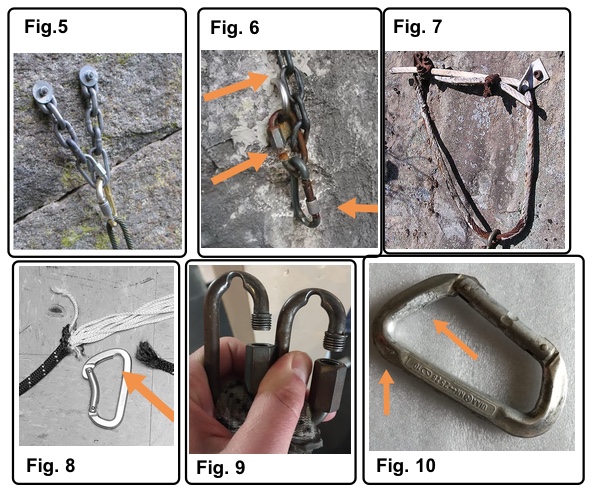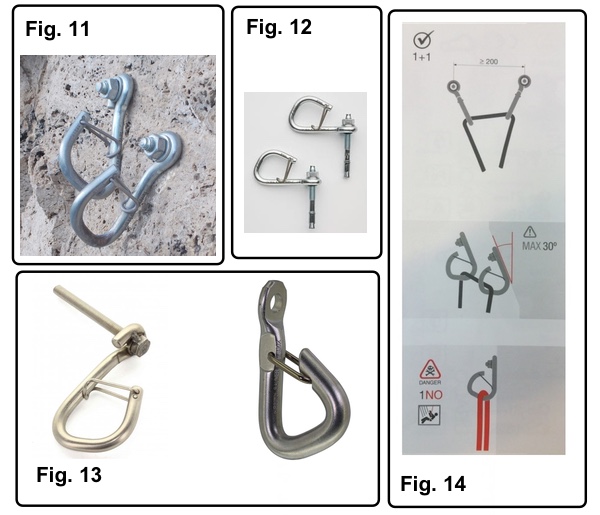Home-made belays (that is not preassembled belays kits). Here are some examples, presented and commented by Gianluca Di Benedetto. Aimed at beginners.

Fig 2) "French" belay
Fig.3) Two bolts linked by a chain
Fig.4) Two not linked rings
The belay is the most sensitive part of a climbing route, the one that needs major attention and safety care. Nevertheless, the belay is almost often the most overlooked part, often made with not certified gears, bought in a not specialized hardware store, often not suitable for climbing or not correctly assembled. Let's try to list the most popular home-made belays and suggest what to do when you find them.
"French" belay
The so-called "French belay" is made of two glue-in bolts, often vertically set, and at a distance of at least 20/30 cm. The lower Anchor serves as a reserve and it's rotated 90°. It's a fairly inexpensive belay, and with a weak visual impact, but often the rope doesn't properly go through it. Moreover, the upper anchor is subject to premature wear, and you must take care not to lock your self to only one of the two anchors.

Fig. 6) Glue-in U-bolt, with damaged and rusty rings
Fig. 7) Dangerous belay!
Figg. 8,9,10) Damaged carabiners and rings!
Two linked bots
Two glue-in or expansion bolts linked by a not certified chain or by a rope: it's a popular solution, in which the anchors are placed at a vertical distance of 20/30 cm or in parallel. In this case, the main aspect to be assessed is the state of wear of the chain or of the rope. Often the rope or the chain are made of a material not certified for climbing, and/or not suitable for the bolts. Special attention should be paid to the element from which you will be lowered down (the not certified carabiner, or ring), to evaluate its state of wear. For example, the presence of incisions or castings is a sign of serious wear, and could damage your rope!
Hanger or glue-in bolt with a ring
A Hanger or a glue.in bolt with a ring is another popular solution, safer than the previous one. the two anchors are set at a vertical distance of almost 20-30 cm: the lower anchor is a hanger with a ring, and both can be linked by a rope, or a chain, or a "maillon rapide". In this case, you must evaluate the state of wear of the elements that connect the two anchors, and the wear of the ring. You may find also two rings not connected to each other: in this case, avoid lowering from only one anchor, and pay attention to the rope friction.

Figg. 12,13) Hooks
Fig. 14) Hooks assembly Instructions (Web)
Hooks
The hooks are a solution like the "French belay", or the belay with rings, with the advantage of saving a maneuver to insert the rope. In this case, you have to see if the distance between the two anchors is adequate and deal with the rope friction. Often the lower hook serves as a reserve. Remember that a kook belay is always not safe if placed in a multi pitches route, because in case of fall the belay turns around.
Bolted chains and Variants
Some belays are made of bolted chains and other variants according to the whims of the route setter, often made of not certified elements. The belays examined so far get more or less close to the safety standards od the preassembled belays kits, but in the real world, you can find some kind of "old fashioned" belays, really not safe for climbing. A comprehensive dissertation about such home-made belays is too complex to be done here, because of too many variables involved: you can find chains bolted on expansion bolts, many kinds of rings, U-bolts, hand.made hangers, steel wires... In these cases you must evaluate every part of the belay, and eventually add some reinforcement, paying special attention to the element from which you will be lowered down, and eventually substituting it with your personal gear.
continues...



Leave a comment